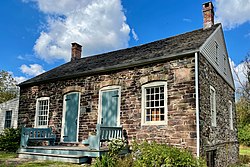
The Steuben House is a noted example of Bergen Dutch sandstone architecture, located at New Bridge Landing on the Hackensack River in River Edge, in Bergen County, New Jersey, United States.

The Wallace House is a Georgian style historic house, which served as the headquarters of General George Washington during the second Middlebrook encampment (1778–79), located at 38 Washington Place, Somerville, Somerset County, New Jersey, United States. It was added to the National Register of Historic Places on December 2, 1970.
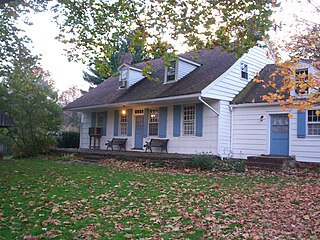
The Van Wickle House, also known as the Symen Van Wickle House, is a historical house located at 1289 Easton Avenue in the Somerset section of Franklin Township, Somerset County, New Jersey, United States. It was built in 1722 by Symen Van Wickle, also known as Symen Van Wicklin. The house, historically known as The Meadows, was added to the National Register of Historic Places on December 4, 1973.

The Bronck House, also known as the Pieter Bronck House, is a historic house museum west of Coxsackie in Greene County, New York. With a construction history dating to 1663, it is believed to be the oldest surviving building in Upstate New York, and is a well-preserved example of early Dutch and Swedish Colonial architecture. It was declared a National Historic Landmark in 1967. It is now a museum property managed by the county historical society.

The West End Hose Company Number 3 is a historic two-story brick firehouse located at 15 North Doughty Avenue in the borough of Somerville in Somerset County, New Jersey, United States. The building was added to the National Register of Historic Places on July 17, 2002 for its significance in architecture and social history. The building is currently the Somerville Fire Department Museum operated by the Somerville Exempt Firemen's Association.

Reformed Dutch Church of Blawenburg, now known as Blawenburg Reformed Church, is a historic church at 424 County Route 518 in the Blawenburg section of Montgomery Township in Somerset County, New Jersey. The Blawenburg Reformed Church Cemetery is located on County Route 601 near CR 518. The church was added to the National Register of Historic Places on July 22, 1985 for its significance in architecture and religion. It was added as a contributing property to the Blawenburg Historic District in 1990.

Van Riper–Hopper House is located in Wayne, Passaic County, New Jersey, United States. The house was built in 1786 and was added to the National Register of Historic Places on August 21, 1972. The house is home to the Wayne Township Museum.

John and Anna Vreeland House, also known as the Hamilton House, is located at 971 Valley Road in the city of Clifton in Passaic County, New Jersey, United States. The farmhouse, built c. 1817 by Anna and John Vreeland, is one of the last symbols of Dutch settlement in the city and one of the finest examples of early 19th century stone houses in the county according to the nomination form. It was added to the National Register of Historic Places on May 13, 1982, for its significance in architecture. It is now operated by the city as a house museum, the Hamilton–Van Wagoner House Museum.
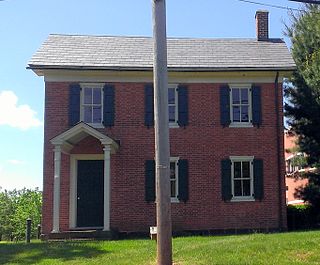
The Andrew Ten Eyck House is a historic farm house located at 671 Old York Road in the township of Branchburg in Somerset County, New Jersey. It was added to the National Register of Historic Places on May 6, 2004, for its significance in architecture.
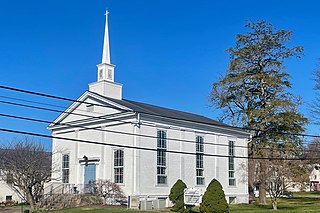
Mount Pleasant is an unincorporated community located along County Route 519 on the border of Alexandria Township and Holland Township, in Hunterdon County, New Jersey. The Mount Pleasant Historic District was listed on the National Register of Historic Places in 1987.

Dutchtown is an unincorporated community located within Montgomery Township in Somerset County, in the U.S. state of New Jersey. The area consists mainly of forested land with some houses grouped around the intersection of Dutchtown-Zion Road and Belle Mead-Blawenberg Road in the northern portion of the township. Also nearby are the Unionville Cemetery and a rock quarry. The Dirck Gulick House was added to the National Register of Historic Places in 2003.

The Kingston Mill Historic District is a 49-acre (20 ha) historic district in Kingston, New Jersey. It is roughly bounded by the Millstone, River, and Princeton-Kingston Roads in the townships of Princeton in Mercer County, South Brunswick in Middlesex County, and Franklin in Somerset County. It was added to the National Register of Historic Places on April 10, 1986 for its significance in engineering, exploration/settlement, industry, and transportation. The district includes 16 contributing buildings and 2 contributing structures.
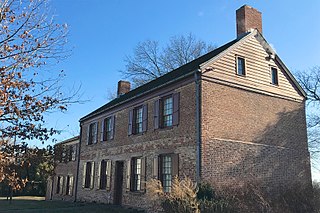
The Van Veghten House is a historic building in the Finderne section of Bridgewater Township, New Jersey. It was built around 1725 and served as the headquarters of Quartermaster General Nathanael Greene during the second Middlebrook encampment (1778–79) in the American Revolutionary War. The Somerset County Historical Society owns the house and uses it as its headquarters, including a museum and library. The early 18th-century Old York Road passed by here connecting Philadelphia to New York City. The house was added to the National Register of Historic Places on October 10, 1979 and noted as representing "one of the few remaining Raritan River mansions".
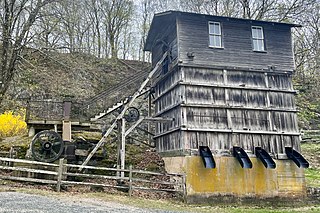
The M. C. Mulligan & Sons Quarry is a 8.8-acre (3.6 ha) historic district encompassing a former limestone quarry located at 56 Main Street in the town of Clinton in Hunterdon County, New Jersey. It was added to the National Register of Historic Places on August 30, 1994, for its significance in agriculture, commerce, and industry. The listing includes six contributing buildings, two contributing structures, a contributing object, and a contributing site. In 1995, it was also listed as part of the Clinton Historic District. The quarry is now in the Red Mill Museum Village, an open-air museum.

The Turner–Chew–Carhart Farm, also known as the Jockey Hollow Farm, is a historic 57-acre (23 ha) farm located off Van Syckles Road in Union Township, Hunterdon County, New Jersey and near Clinton. It was added to the National Register of Historic Places on August 11, 1977, for its significance in agriculture, architecture, industry, and politics/government. The farmstead includes seven contributing buildings.

Franklin Corners is an unincorporated community located along the Passaic River at the intersection of County Route 613 and U.S. Route 202 in Bernards Township of Somerset County, New Jersey. In the 19th century, it had a grist mill, saw mill, general store, school, and several houses. The Franklin Corners Historic District, featuring Van Dorn's Mill, was listed on the National Register of Historic Places in 1975.

The Simon Van Duyne House is a historic house located at 58 Maple Avenue in the Pine Brook section of the township of Montville in Morris County, New Jersey. The oldest section was built c. 1750. It was documented by the Historic American Buildings Survey in 1936. The house was later added to the National Register of Historic Places on January 17, 1992, for its significance in architecture. The house was also listed as part of the Dutch Stone Houses in Montville, New Jersey Multiple Property Submission (MPS).

The Mead–Van Duyne House is a historic stone house that was originally located at 636 Fairfield Road in the Mountain View section of the township of Wayne in Passaic County, New Jersey. The oldest section of the house dates to 1706. It is the second oldest surviving Dutch stone house in the county. It was documented by the Historic American Buildings Survey in 1938. Listed as the William Klein property, it was added to the National Register of Historic Places on August 12, 1971, for its significance in architecture, military history, and religion/philosophy. In 1974, the building was relocated to 543 Berdan Avenue, next to the Van Riper–Hopper House, as part of the Wayne Museum. It was renominated as the Van Duyne House in 1976. It was relisted on the state register on March 15, 1976. The property was withdrawn from the NRHP on December 15, 1976.
